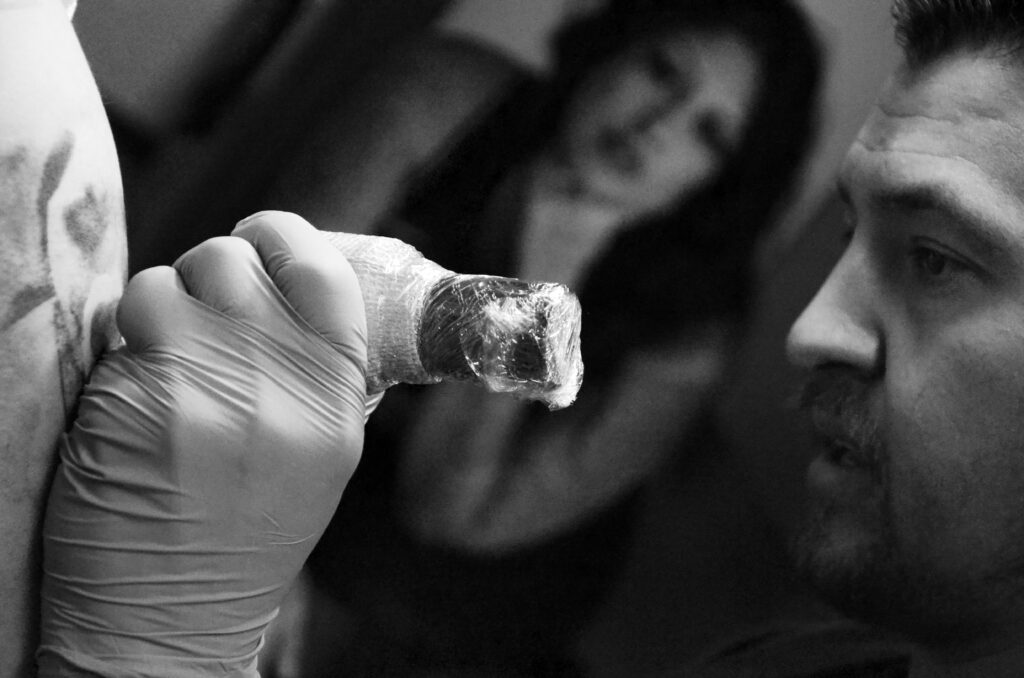By Jesse Jones/ NM News Port
There you are, reclining comfortably and telling a professional your innermost fears and dreams.
But you’re not at a therapist’s office, you’re at a tattoo shop working with an artist while they bring a chapter of your personal story to life, putting needle to flesh.
During that time you can get to know your tattoo artist and they become a person to open up and discuss anything that is on your mind.





“It’s confidential. You’re here. More time to get tattooed, talk about what you’re feeling, thinking or don’t, stay quiet and relax. Tattooing is therapy, I call it tattoo therapy.” Says Johnny Benavidez, owner and tattoo artist at Aesthetic Ink.
Tattoos have multiple therapeutic qualities that other artforms do not have.
The first, is collaborating with the artist to create a design. Benavidez says he uses the customers ideas and concepts but he makes it how he thinks it should be.
Next is getting tattooed, depending on the size and how elaborate the design is, it may take multiple sessions at a time.
This is the period that can be the most therapeutic. For some, getting tattooed is painful and talking to the artist is a way of tuning out the pain. Other people might want to focus on the sensation in a kind of meditation.
The last step after the tattoo is completed is the most transformative.
Once completed the tattoo is primarily meant to be seen. But other people who see the tattoo are secondary participants and have the ability to transform the tattooed person’s identity positively or negatively depending on any number of factors including where on the body the tattoo is located.
“When you have a giant f*****g area code on your face, suddenly when you get pulled over, it’s not how you doing sir, its put your f*****g hands up,” says Rick Gandara, a tattoo artist at Poison Apple Tattoo, “Your life changes, you know, because of other people’s assumptions.”




Like body hieroglyphics, tattoos can narrate people’s lives and represent their identities whether it be positive or negative.
Each person has a wide spectrum of experiences, getting tattoos is a way to focus their narrative.
“Each tattoo can be viewed as a symbol of an episode or scene in the narrative of one’s life,” says Jeff Murray, marketing professor at the University of Arkansas in his paper titled, Inscribing the Myth: the Role of Tattoos in Identification.
Like many artforms, many tattoos are meant to be seen. For some, getting tattooed might make a statement, it could show cultural, family or group identity.
“My whole inner arm I have a little New Mexico scenery. So Johnny did this and I guess just kind of my identity as a New Mexican,” says Jackie Benavidez, a customer getting a tattoo at Aesthetic Ink.
There is currently no official New Mexico tattoo but if there was, it would undeniably be the Zia symbol. The Zia symbol comes from the Zia Pueblo where it is a sacred image, much like the crescent moon and star is for Islam, the cross is for Christians and the star of David is for Jewish people.
According to tattmag.com, “those looking to get a Zia tattoo – the Zia tribe would ask that you brush up on your history and ask permission.”
Unfortunately, there are probably not many people who ask permission from the Pueblo.
Others may get tattoos as a memorial, a badge of honor, a celebratory statement or to show their strength to overcome some major adversity like cancer.
Gandara says people get things, “like integrity on the wrist just so they look and read it and remember not to be an a*****e.”
According to CNBC.com, a Rasmussen Reports survey reports that 33 percent of Americans have tattoos. The popularity of tattoos among Gen Z, Millennials and Gen X means that many companies have relaxed old rules forbidding tattoos at work. This is a sign of how much a part of American culture they are.
Tattoos are becoming so popular in the US and around the world that even doctors are using them to help with exams.
A trio of researchers published a paper in the World Journal of Psychiatry that says, including a patient’s tattoos as an element of psychiatric treatment can help doctors and patients explore “the personal meaning of skin art and self-identity.” And recommend looking at tattoos as a part of the regular physical examination because they can be “a valuable window into the psyche.”
The word hieroglyphic, means sacred carving in Greek and tattoos can act as the hieroglyphic chapters for the personal myth of the people who get them. Tattoos have worked and will continue to be many people’s self-care without ever having to step foot into a therapist’s office.
Follow Jesse on Twitter @jpjones505
Follow Jesse’s Facebook page Jesse P Jones Photography
Follow Jesse on Instagram @jpjones505
Jesse’s website is jessejonesphotography.com